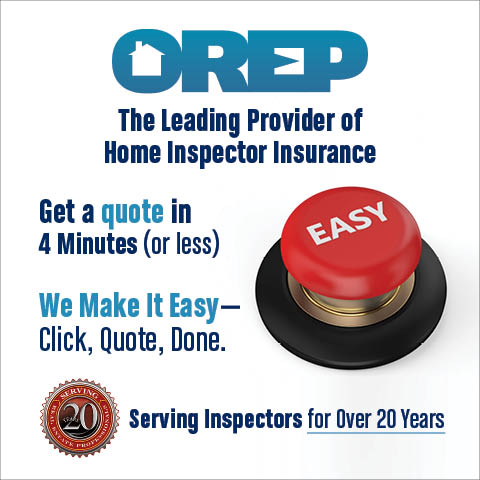 | > E&O/GL Insurance for Home Inspectors Competitive Rates, Broad Coverage, Free Risk Management, online inspection support for tough questions, discounts on education and more... Professional Coverage, Competitive Pricing Shop OREP today! |
>> Editor’s Note: To help you stay up-to-date and connected, OREP/Working RE has established a Coronavirus (COVID-19) Discussion and Resource Page where you can share your thoughts, experiences, advice and challenges with fellow inspectors. See what Inspectors are saying here!
Don’t Walk Away from Running Water
by Isaac Peck, Editor
The title says it all, doesn’t it?
All joking aside, accidental home flooding happens more often than you would think. Home inspectors, who are otherwise careful, well-trained, and conscientious, do inadvertently flood the bathroom, kitchen or laundry room. The result is a costly cleanup and repair, not to mention a public relations nightmare as the inspector then has to explain what happened to the homeowner, all real estate agents involved and their client. It’s not pretty and can cost you business and future referrals, not to mention the costly repair and clean-up costs if you’re not insured.
Here are a few scenarios of how this happens.
Shower, Bathtub, Sink
After washing machine floods, the next most common scenario involves flooding the bathroom.
In a video titled “Home Inspection Fail Files: Bathtub Floor,” posted to his Structure Tech Home Inspections YouTube channel, Rueben Saltzman, CEO of Structure Tech tells the story of how this happened to him seven years ago.
First, you might be asking: why fill up the bathtub at all though? Neither ASHI or InterNACHI Standards of Practice (SOP) require the home inspector to fill up or test shower pans and bathtubs. For example, the ASHI SOP states: “The inspector is not required to fill shower pans and fixtures to test for leaks.”
Even though not required by most SOPs, Saltzman says he still thinks it’s a good idea to test bathtub overflows. “We start our home inspection by filling up the bathtub and I think home inspectors ought to check those. I never used to inspect bathtub overflows. I once had a client call up two months after my inspection saying that the first time they used the bathtub it overflowed like crazy, the overflow drain didn’t work, and it flooded the ceiling. ‘Why didn’t you check the bathtub?’ I explained to my client that we didn’t do that as part of our SOP. But since then I think it’s a really good idea to check bathtub overflows to make sure they don’t leak and make sure that the client is protected,” argues Saltzman.
Back to Saltzman’s story: he explains that he was training another home inspector at the time and the bathtub in the master bathroom was a “gigantic” two-person bathtub. “We got the entire second floor inspected and this tub was still only half full. So instead of just sitting around doing nothing, we said we’ll continue on with the first floor and come back in five or 10 minutes to see how it’s doing. Fast-forward 20 or 30 minutes and I see water coming out of a place in the ceiling while I was in the basement,” says Saltzman. The realization hit him like a ton of bricks. “All of a sudden it clicked that I never shut that tub off. And I felt my face turn beet red instantly and I ran upstairs. My other inspector was already there using all the towels at his disposal to clean up one of the biggest messes you’ve ever seen. That tub overflowed and it really made a huge mess. That made me question whether I was in the right line of business. It was such a stupid mistake and I don’t know how anybody could do something like that. I don’t think I slept that night,” says Saltzman.
Saltzman explains that this event happened seven years ago—he just now feels comfortable talking about it. “I’m over it now, it’s only seven years later,” he jokes. But even still, at the time, he had over 10 years of home inspection experience under his belt. Saltzman runs a very successful home inspection firm in MN, and has served as the ASHI Heartland Chapter President as well as on the Board of Directors for ASHI National. Suffice it to say that if this can happen to Saltzman, it can happen to you
(story continues below)

(story continues)
“I’m telling this story as a precaution to other home inspectors out there. I still test bathtubs because I think it’s the right thing to do. And I still encourage you to test bathtub overflows even though you’re not required to. My advice to home inspectors is (1) Don’t leave the bathroom, (2) if you do absolutely have to leave the bathroom, set a timer or get yourself a water alarm. You can stick the alarm right near the overflow, so that whenever the water gets close to the overflow your alarm goes off,” advises Saltzman.
Here at OREP, we would advise you to stick to Saltzman’s first recommendation as much as possible: don’t walk away from running water. Just don’t do it.
Laundry Equipment
Despite what the title suggests, it’s not just running a faucet or shower that can cause a problem. How about the washing machine? We’ve seen cases where a home inspector runs the washing machine to “test” it, but the drain line isn’t connected to the wall drain. The home inspector starts the washing machine and then leaves the room. “I’ll come back in 30 minutes and check how it’s going,” the inspector might think. Then 30 minutes later, the washing machine has drained gallons and gallons of water all over home and the result is damaged flooring, water-logged baseboards and drywall, and sometimes extensive water damage that requires a professional restoration contractor to repair.
Like testing bathtub overflows, testing a washing machine is not required by ASHI or InterNACHI SOPs. If you do decide to go the extra mile and operate the washing machine or other home systems that involve draining water, you need to make sure the drain hoses are connected and stay very present and in close proximity during the “test.”
Liability and Risk Management
Here at OREP, we have seen enough cases like this to know that it does happen, even to experienced, well-trained inspectors. Sometimes the inspector becomes impatient waiting for the bathtub to fill. We’ve have seen cases where the home inspector receives a call while testing the bathtub or shower, and then steps out of the room to take the call.
In some cases, a flooded bathroom can turn into a flooded master closet, flooded master bedroom, etc. The damages for cleanup and repair can be extensive as flooring, drywall, baseboards, and even ceilings may need to be repaired or replaced. On the high end, we have seen damages exceed $20,000 for a claim like this. In extreme cases, in addition to the cost of repairs, the homeowner (seller) might also demand money for the costs of delays in the home sale, carrying costs of the home while it is being repaired, and even the cost of alternative living arrangements due to mold concerns and “health issues.”
OREP’s primary program employs a team of experienced claims adjusters and attorneys who specialize in home inspector liability, and we do our best to defend our insureds. However, as you might imagine, it’s hard to get you out of a claim where you are personally responsible for flooding someone else’s home. So be careful and stay safe out there! Visit OREP.org for comprehensive home inspector E&O insurance and expert risk management—serving inspectors for over 19 years.
About the Author
Isaac Peck is the Editor of Working RE magazine and the President of OREP, a leading provider of E&O insurance for appraisers, inspectors, and other real estate professionals in 50 states. He received his master’s degree in accounting at San Diego State University. Reach Isaac at isaac@orep.org or call (888) 347-5273. CA License #4116465.
OREP/WRE Coronavirus Discussion and Resource Page
Coronavirus: National Home Inspector Survey
Real-Life Inspector Lawsuits and How to Protect Yourself
Available Now
Presenter: Isaac Peck, President of OREP
Isaac Peck, President of OREP Insurance Services, shares his insights and advice gained over nearly 10 years of providing risk management and E&O insurance for home inspectors. You will not hear many of these insights anywhere else.
Watch Now!
Note: The Fall 2021 issue of Working RE Home Inspector is mailing now to over 25,000 home inspectors nationwide. OREP Insureds enjoy guaranteed delivery of each print magazine and many more benefits.


